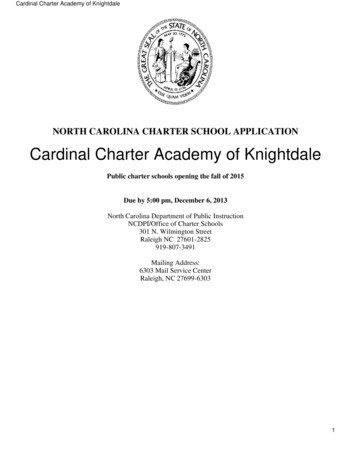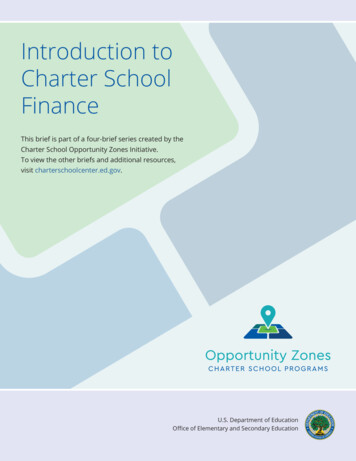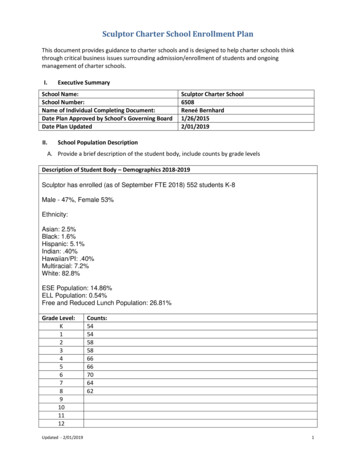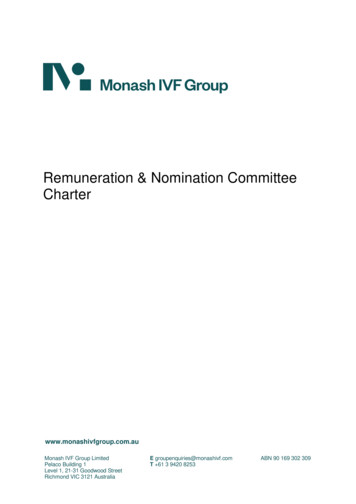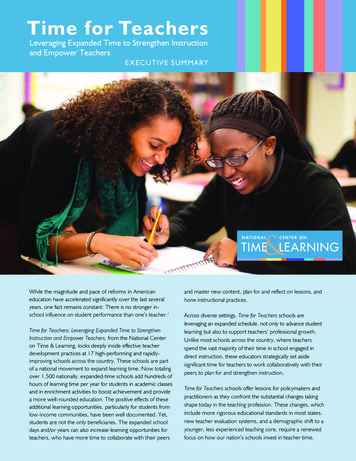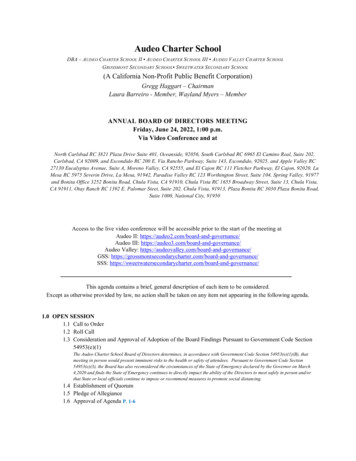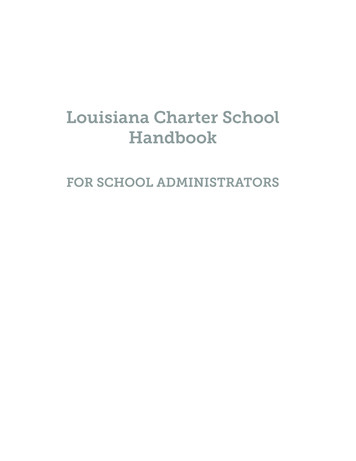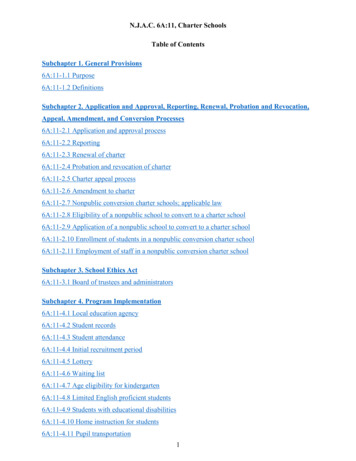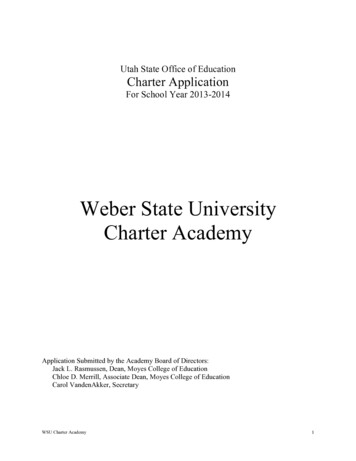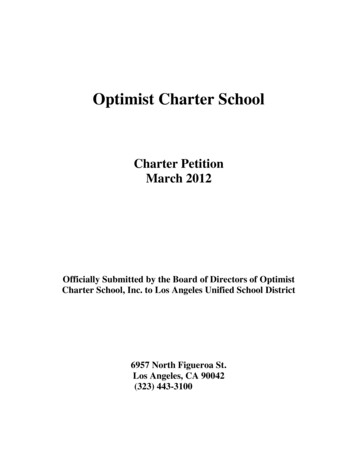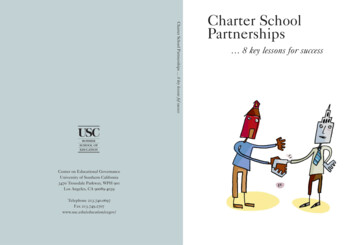
Transcription
Charter School Partnerships 8 key lessons fof successCenter on Educational GovernanceUniversity of Southern California3470 Trousdale Parkway, WPH 901Los Angeles, CA 90089-4039Telephone 213.740.0697Fax 213.749.2707www.usc.edu/education/cegov/Charter SchoolPartnerships 8 key lessons for success
Charter SchoolPartnerships 8 key lessons for successPriscilla Wohlstetter, Joanna Smith,Courtney L. Malloy, and Guilbert C. HentschkeCenter on Educational GovernanceRossier School of EducationUniversity of Southern CaliforniaLos Angeles, CA
AcknowledgementsWe would like to thank the leaders from the 22 charter schools acrossthe nation that we visited for this study as well as the leaders from theirmany partner organizations. Without the cooperation and support of thenearly 150 people we interviewed, this guidebook would not offer therichness and authenticity afforded by their experiences. Specifically, wewould like to thank the following charter schools: 2005Center on Educational Governance,University of Southern California,All Rights Reserved.Design: Denton Design AssociatesIllustration: Elizabeth BurrillAgricultural and Food Sciences Academy, Little Canada, MinnesotaBishop Hall Charter School, Thomasville, GeorgiaBoulder Preparatory High School, Boulder, ColoradoCharles R. Drew Charter School, Atlanta, GeorgiaConstruction Careers Center, St. Louis, MissouriDella Lamb Elementary Charter School Kansas City, MissouriEast Bay Conservation Corps Charter School Oakland, CaliforniaFlagstaff Arts and Leadership Academy Flagstaff, ArizonaFriendship Edison Public Charter School Washington, D.C.Gennessee Community Charter School Rochester, New YorkJohn Baker Charter High School for Incarcerated Youth, Raleigh,North CarolinaKIPP Academy, Bronx, New YorkMesa Arts Academy, Mesa, ArizonaNuestros Valores Charter School, Albuquerque, New MexicoOrange County High School of the Arts, Santa Ana, CaliforniaPalm Beach Maritime Academy, West Palm Beach, FloridaPueblo School for Arts and Sciences, Pueblo, ColoradoRyder Elementary Charter School, Miami, FloridaSallie B. Howard School for the Arts and Education, Wilson,North CarolinaSchool for Arts in Learning, Washington, D.C.Schoolcraft Learning Academy, Bemidji, MinnesotaTaos Municipal Charter School, Ranchos de Taos, New Mexico3
The research has also benefited from the dedication of severalindividuals, including Diane Becket, Jennifer Hicks, and Lucy Okumo,who traveled the U.S. to help collect data for the study.This guidebook on charter school partnerships was prepared bythe Center on Educational Governance at the University of SouthernCalifornia. The Center on Educational Governance combines researchaimed at building new theories about what makes schools work withaction research and dissemination activities to spread best practicesbroadly and deeply. Our aim with this guidebook is to provide usefulinformation to the many educators and community leaders across thecountry engaged in charter school partnerships.The research was supported by generous grants from the U.S.Department of Education Public Charter Schools Program, theAhmanson Foundation, and the Annie E. Casey Foundation. We thankthem for their support but acknowledge that the findings presentedhere are those of the authors alone, and do not necessarily reflect theopinions of these organizations.We dedicate this book to the risk-takers who launch partnershipsand their partners who contribute to improving public education.Priscilla WohlstetterJoanna SmithCourtney L. MalloyGuilbert C. HentschkeCenter on Educational GovernanceRossier School of EducationUniversity of Southern CaliforniaLos Angeles, CA4IntroductionIf you are considering forming a charter school, you are following inthe footsteps of thousands of others who were similarly motivated tocreate new educational opportunities for students in their community.Maybe you are driven by dissatisfaction with local school options ora desire to establish a school that will offer a unique curriculum.Researchers from the Center on Educational Governance at theUniversity of Southern California’s Rossier School of Education spenttwo years speaking with nearly 150 people involved with forming andmanaging charter schools that shared one common characteristic: Theychose to enter into partnerships with nonprofit, for-profit and publicorganizations to help establish and operate the schools.This guidebook represents the experiences of the 22 charterschools visited across the nation and offers a variety of lessons learnedabout how to form and sustain mutually beneficial partnerships. As youconsider your plans and ideas, you can learn from others’ experiencesto help guide your own choices.Before we begin, it is important to note that all charter school partnerships are not alike. The types of partnerships that exist betweencharter schools and other organizations can be distinguished based onthree characteristics: What is the nature of resources exchanged in the partnership? What is the form of the partnership? What is the depth of involvement in the partnership?5
The types of organizations charter schools elect to partner withvary widely but commonly include the following:Pa r t n e r s h i p d i m e n s i o n sResource exchangeFormDepthFinancial resourcesInformal agreementsOne-level involvementHuman resourcesFormal agreementsMulti-level involvementSectorTypes of Organizations (examples)NONPROFITCommunity-based organizations (recreational centers, neighborhoodoutreach agencies)Cultural institutions (museums, local performance groups)Educational institutions (private colleges, universities)Faith-based organizations (churches)Nonprofit educational management organizationsRace/ethnic-based organizationsSocial service providers (child and family welfare agencies)Private foundationsFOR-PROFITEducation management organizationsLocal businessesPUBLICCultural institutions (art museums, science museums)Educational institutions (school districts, communitycolleges, universities)Public health providers (hospitals)Government/Municipalities (city offices, mayor’s office)Police departmentsPhysical resourcesOrganizational resourcesAlso, we found that partnerships do not spring up fully formed. Rather,they progress through a series of stages, as shown in the diagram below.The lessons in this guidebook will help you progress successfullythrough this ASE123In the first phase,initiation, the existenceof a leader to champion the effort helpsorganizations that aremotivated to partnerdevelop the purposefor the partnership.6In the second phase ofpartnership development, the operationsphase, certain structures and processes arecreated for decisionmaking and for disseminating information to help thepartnership function.Finally, in the evaluation phase, the effectsof the partnership areassessed. Dependingon the results, thepartnership maycontinue as is or bemodified to improveits outcomes.These partners provide a variety of financial, human, physical, andorganizational resources. In the charter schools we visited, partnersoffered resources ranging from direct financial support for one-time orongoing needs, use of classroom or athletic facilities, access to speakersor mentors, expertise in developing curriculum, business/managementinfrastructure and expertise, internship or work-study opportunities,and know-how in promoting the school through the media, to namejust a few. Associations with established partners can also lend neededcredibility to bolster the charter application, attract students, and broaden community support for the school.Before delving further into the planning process for your charterschool, take some time to review the following eight key lessons takenfrom our interviews with leaders from charter schools and their partners. Their experiences may help you decide if a partnership wouldbenefit your charter school.7
lesson1.Weigh the Benefitsand Costs of Partnering
Is partneringreally anadvantage?“You can’t take everypartner that walks throughthe door. I have to ask,‘Is it going to cost me morein time and money thanit’s worth?’”10An established partner can offer a range ofresources—additional finances, a unique curriculum, access to facilities—needed for aschool’s survival. Some charter school leadersacknowledged that, were it not for the fundsprovided by a partner, the school simplywould not exist. Contributions ranged from afew thousand dollars for supplies to assistanceobtaining a 20 million bank loan. Partnerships also provided access to a range of facilities including classroom space, athletic fields,and meeting halls. Further, partnershipsimparted credibility to newly-formed charterschools. In some cases, charter schools usedthe reputations of their partners to gain accessto commercial credit, while others leveraged itto tap into publicly available funds such asgrants and awards.Charter school leaders are often equippedwith strong education credentials, but manylack business experience. Partners with business expertise can alleviate the need forschool personnel to become experts in hiring,contracting, budgeting and other businesstasks. In this way, partners can help fulfilladministrative duties and let the charter operators focus on curriculum and instruction.However, partnerships also requireresources—time and human resource costs—to actively build, operate, and sustain the relationship. Partnerships are rarely one-waystreets; if the costs exceed the likely benefits,you may want to reevaluate whether it’s inyour interest to make a deal.P O I N T- C O U N T E R P O I N T:The Benefits and Costs of Sharing a Facility“Because we are all in one building, it is simple. Wedon’t have a lot of meetings but we have a lot of conversations. It’s not like everything has to be written in a memo format. We are small enough that things are informal which is abenefit We can meet in the hall or go up and knock onsomeone’s door.”BENEFIT:COST: “There was a conflict of personalities in the past. It wassort of ‘us against them.’ But, we have to share the facility.You have to eventually figure out that the partnership is anadvantage and work together.”“I like the idea that I can drop my child off in themorning and they are physically here the whole day, becauseof the immediate after school program.”BENEFIT:“We have struggled to integrate programs at times. Forexample, the after school and summer programs need to usethe school facilities. Teachers have been concerned aboutsharing the facilities; they feel like they’ve lost their turf.”COST:“The facility at the cultural center is very grand, so tobe able to have graduation here signals to the students andtheir families that the child has really accomplished something. That kind of confidence and pride is more importantthan anything they can learn in school.”BENEFIT:11
Get readyfor the politicsof partneringOften, a partnership with a well-establishedorganization provides greater name recognition to help promote your school. Somecharter schools that were launched with thesupport of prominent businesses, communitymembers or local politicians benefited fromimmediate community acceptance, whileothers utilized assistance from partners tonavigate the application process and securefunding or resources for other student needs.However, partners also need to be prepared for possible negative attention frompartnering with a charter school. Partners may become subject to requirementsfor open meetings and other public accessrules. Since charter schools receive publicfunds, private partners may have to make certain school-related decisions in an open forum. Community opposition to charter schools cancarry over to the partner—even one thatenjoys high public esteem. If the students fail to perform to expectations,even a well-regarded partner could find itselfwith a share of the blame.“A big part of our success in thebeginning was having the companyname. Having a partnershipwith a major corporation is agreat benefit in many ways. Therewas national publicity when weopened. We were full in two monthsof opening our doors.”12Can yougive as goodas you get?Some partnerships are tightly defined and thecontributions of both sides complement thecharter school’s goals. In such cases a partnermay offer access to curriculum enhancementsor special programs, mentors or specializedequipment or facilities that truly enhance theeducational experience for students andteachers. In turn, charter schools often supplyeager student volunteers or interns, as well asa network of families to support the partner inother beneficial ways. In the case of a schoolpartnered with an art museum, students gainedaccess to artists, program advisement and themuseum’s facilities in exchange for access to fundingfrom the charter school.However, in some cases the partnerorganization may provide a service unfamiliarto the teaching staff and administration. Thetime costs associated with figuring out how totake full advantage of the opportunities available can be frustrating and deny students anyreal benefit. In the case of a charter school thatpartnered with an expeditionary learning organization, a major challenge was figuring out how tointegrate the new curriculum into the school’s existing educational program.You also need to beware of unbalancedsituations, so that one of the partners does not13
feel that it is providing more than its fair shareof time and resources. Individuals or organizations that put other projects aside to focus onopening or operating the charter school shouldconsider how this will affect their other work.Commitments of staff or facilities that seemedlike a good idea at one time may ultimatelybreed resentment among staff or other constituents.lesson2.Do Your Homework andChoose Your Partner Well“Opportunity cost issues set in—other issues that were shelvedin order to focus on our partnershipwith the charter school don’t goaway and eventually need to beput back on the front burner.”1415
Trust is thefoundationA crucial factor when deciding to form apartnership is whether or not the two partiescan trust each other. Without a fundamentalsense that the other side is going to “deliver,”or do their utmost to uphold the principlesof the partnership, it can be difficult to feelcomfortable collaborating on key educationalprograms, fundraising and other tasks essential to the partnership’s success. For thisreason, the personal relationships betweenpartners are often key to establishing a highlevel of trust.“Partnerships work because ofpersonal relationships. We havetrust and rapport. They know I willdeliver.”Common goals helppartners stay focused16Many charter school leaders reported thatthe best partnerships are born from a unifiedvision of goals and objectives. In some cases,partners may simply share a philosophicalapproach that supplies the drive and enthusiasm to make the relationship work. In othercases, partners might have similar approachesto enriching instruction and curriculum.Charter schools that find themselves tiedto partners with differing goals may havetrouble accomplishing the desired objectives,not to mention managing and sustaining thepartnership.“In our partnerships,we are trying tomarry education andbusiness in a way thatfew organizations havesuccessfully done in thepast.”Partners withcomplementary needsare partners indeedPartnerships also succeed on the basis ofneeds that complement one another. Overtime, charter schools have formed partnerships with a wide range of organizations with an equally varied number ofassets. Some of the best relationshipsemerged from an ability to provide eachpartner with the materials, resources andstaff to satisfy operational needs.In some cases, charter schools may beable to use facilities a partner can nolonger maintain without help, or provide aneeded investment in a redevelopmentzone that helps spur neighborhood recovery. Often, charter schools can provideinterns at a partner organization thatmight have trouble recruiting newtrainees, in exchange for access to educational programs normally reserved formore advanced students.17
QACan youWhat sealed the deal for you?A: “We had a common belief that education iscritical for kids to be successful and contributing citizens.”A: “The similarity in mission and their focuson world cultures, language, and socialresponsibility helped . Philosophically,we had no problem.”both commit?A partnership may look great on paper andmake a lot of sense to the people who conceived the idea, but the relationship willrarely be sustained without long-term commitment from both sides. A few importantpoints to keep in mind are: Entire organizations have to stay committed tothe partnership over time, even if leadershipchanges or budgets fluctuate.A: “[They were] the kind of partner you diefor. They are our ‘ace in the hole’ formaking this work.” Organizations with multiple layers of staff thatbecome involved will need the buy-in fromeveryone in order for the partnership to work.A: “Everybody wins on this one. We get finearts courses aligned with the college curriculum for our students . Our studentsget community college credits, while stillenrolled in our high school.” Organizations requiring the support ofexternal stakeholders should realisticallyassess whether those distant participants willshare the same level of enthusiasm for thepartnership.A: “The museum complements our curriculumso completely; that’s what their collection and expertise is in.”“You can’t make itwithout commitment.”A: “We clicked. We had a similar vision.”A: “People at [the school] were warm, friendly, and engaging. They had good heartsand were not about the bottom line.”A: “We both want to give back to the community. Also, communication, dialogue,honesty are all prevalent, making them agood match.”A: “The main thing is that for it to work rightdemands an incredible amount of commitment and they were willing to give100%.”1819
The Partnering Prowessof One Charter School LeaderWe talked to Joanna Lennon, founder and CEO of the EastBay Conservation Corps in Oakland, California about openinga charter school and her ensuing search for good partners.Here’s what this veteran community leader involved in partnering had to say:Q: When did you start the East Bay Conservation Corps (EBCC)?A: I started the EBCC in May of 1983. I learned that I could contribute more to the greater good by working at the local level.Also, working at the local level has the potential to create modelswhich have national and international relevance for replication.Q: Tell me about the decision to open the EBCC charter school.A: My role at the EBCC is to provide the vision and the leadershipfor embarking on new endeavors which address issues of socialchange and education reform. What I’m really good at is seeingconnections and envisioning what is possible.The reason the EBCC decided to start a charter is because wehad a twenty-year history of working in partnership with schoolsand districts designing and implementing programs whichengaged young people as active participants in their communitiesand found that there were limitations in our roles as a partner.The charter school movement provided us with an opportunity todevelop a school with a very specific vision, mission and guidingprinciples from the ground up where we had the autonomy andfreedom to try new things. We also wanted to explore the idea ofhow partnerships could play a very important role in sustainingpublic education, particularly given the limited available ADA(average daily attendance) funding in California.20Q: The charter school has a lot of different partnerships.How were they established?A: The EBCC has a long history of developing partnerships in thecommunities we serve including partnerships with local nonprofits, city municipalities, colleges and universities, foundations andthe business community. We realized that the vision and missionof the charter school offered a truly compelling opportunity forpartners to reinvest in the civic purpose of public education whileat the same time furthering their own goals. This was really awin-win situation for us and for our partners because both benefited substantially. For example, one of the largest constructioncompanies in the nation, Webcor, provided us with significantplanning and renovation of our nearly 100 year old school site.This relationship developed because I happened to see an advertisement during 60 Minutes about how Webcor prided itself ingiving back to the communities where they did business. Also, itjust so happened that the CEO of Webcor was a member of thesame congregation where I attend church and so there was a natural opportunity to approach him. Not everyone would necessarily feel comfortable pursuing such a relationship and yet we havefound again and again that taking chances is well worth the risk,because you will never get anything unless you ask and drawingon relationships is the best place to start. What Webcor got out ofthe partnership was not just the satisfaction of doing good workin the community, but a lot of good media coverage whichenhanced their business. In addition, this partnership led toWebcor’s involvement as a leader in the community in new ways.Q: What advice do you have for other charter school operators interested instarting partnerships?A: You need to be clear and strong about your vision and missionbut also need to be fearless in exploring opportunities whichseem far fetched. The best partnerships are based not just on ashared commitment to a vision or outcome but also on distinctand significant benefits to each partner.21
lesson3.Clearly Definethe PartnershipAgree onan agreementSelecting your partner requires a great deal ofthought and effort, but equally important ishow you choose to structure the partnershipsince it will help define the relationship foryears to come.Arrangements can range from an informal“handshake” or a somewhat more structuredmemorandum of understanding (MOU) to acontract or lease with legally binding obligations. Each level of commitment carries positive and negative aspects. An informal arrangement is usually based onpersonal relationships in which both sides feela strong commitment to the ideals of the partnership. MOUs provide clearer guidelines for partnerresponsibilities, but do not carry the samelegal implications as formal contracts. Contracts and leases are legally binding documents that typically obligate both sides to provide a set level of service or face certain consequences.Informal relationships benefit from the flexibility inherent in any agreement that is basedon the goodwill of two parties. However, ifthere are changes in management, or if theorganizations’ circumstances change, the partnership could face several challenges withoutany recourse for partners.With more formal MOUs, contracts orleases, there is less ambiguity about what eachside will contribute, alleviating many potentialconflicts that can arise as different people2223
cycle into roles that affect the partnership.However, formal agreements also create a perception of “enforcement” which can create arelationship that seems too rigid.In more complex arrangements, such aswith Education Management Organizations(EMOs) that provide support services rangingfrom basic transportation assistance to wholeschool management, detailed contracts areoften necessary and advisable because of theextent of services provided. However, theyalso should be flexible and open to renegotiation at specified periods.Accountabilityplanning: devisePeriodic audits and performance reports canalso be mandated in a formal agreement.Funding sources often require evaluationsand reports to justify the use of their money.If your school is subject to oversight from aboard of directors, the board will likelyrequire periodic reports on performance thatwill be evaluated against an accountabilityplan.“ We, as partners, have toevaluate our fiscal viability, whichmeans building in systems toimprove our practice.”Along with an agreement comes the need todevelop an accountability plan that details thegoals of the partnership and partner responsibilities. Accountability plans should address:and conquer How the partnership will be evaluated The consequence of poor performance A course of action to terminate the partnershipAccountability can be measured in a numberof ways, including feedback from teachers andstudents to determine if they are benefitingfrom their contacts with the partners. Manycharter schools rely on evaluation forms forteachers and students to provide feedbackand, in some cases, parents are surveyed tofind out their perceptions of the partnership.2425
QALet’s Talk AccountabilityQ: How do you deal with poor performancein your partnership?A: “It’s too early to tell. The partnershipjust started less than a year ago andmost of our time has been spent gettingfaculty hired and the curriculumapproved.”A: “There are many structures in placethat are more therapeutic than punitiveto help schools that are not performingwell.”lesson4.Setting Things inMotion: CreatingStructuresfor ParticipationA: “If the graduation rate doesn’t reachthe county’s goal of 80%, foundationswouldn’t want to put money in. Plus,we’d lose our charter after 5 years.”A: “There are no consequences. We’renot pulling the money if the success isnot at the expected level. If it fails, itfails, but we couldn’t risk not trying it.”A: “We are not blindly grateful to ourpartners. We have needed to dissolvepartnerships in the past. If they don’twork out, we move on.”A: “If it’s something we can fix, we fixit, but we know we can’t please 100%of the people 100% of the time, so wedon’t try to.”A: “We vote with our feet.”2627
Views around town:What’s the most important factor to ensureyour partnership will operate smoothly?the partnershow to run superiorpartnerships“They don’t feel ‘entitled’ to our help, sothey’re not unpleasantly demanding.”— Bishop Hall Charter School“One of the things we believe contributes tofailure is a lack of planning. We had a threeyear planning process, so we really understoodthe infrastructure of the partnership before weopened the charter school’s doors. That’s whatmakes it work.”— East Bay Conservation Corps Charter School“You have to always be open and honest withone another or else the partnership won’twork.”— Flagstaff Arts and Leadership Academy“It’s like a good marriage. You need to cometo the table with who they are today, not whothey were yesterday. Forgiveness instead offinger-pointing.”— Gennesee Community Charter School“Commitment to education on the part of allinvolved. There are no coasters at the charterschool or at the university. It is an active partnership.”— Pueblo School for Arts and Sciences28Governance ofOperating a partnership requires processesand methods for sharing ideas, making decisions and developing a collaborative environment. When assembling a partnership, paycareful attention to the structures put inplace to raise, discuss and decide importantissues. You might ask yourself the followingquestions: Will you use informal meetings to addressissues on an ad hoc basis? Should you create formal committees thatmeet at regular intervals? Should there be a decision-making body towhich the committee members report recommendations? Will a committee structure put a damper onthe creative process the school is tryingto foster? If the committees are divided equally betweenschool and partner representatives, who willhave the final say?Members of the partner organization whoserve on school committees or boards havethe potential to become ambassadors for thecharter school, if they have a positive experience in the role. On the other hand, if thenumber of committee meetings and obliga-“ This partnership operateswith dialogue and consensus.”29
tions becomes onerous, partner representatives could become tired of the responsibilityand become less enthusiastic advocates forthe school. It is important to maintain a careful balance between full inclusion in thedecision-making process and over-exposure.The 3 C’s:Communication,Communication,CommunicationA collaborative governance structure is strongly supported by an open dialogue that notonly keeps news and information flowingbetween partners, but also fosters a feeling ofopenness that encourages people to contribute and share.In addition to top-down information sharing, it is important and helpful to foster anenvironment in which teachers and staff feelthat their ideas are valued and expected.The information flow, whether formal throughletters or meetings, or informal through conversations and emails, helps to coordinateactivities, fine-tune programs and distributemanagement duties.“ We’re creating anatmosphere where wecan have good, honestconversation. The keyto our partnership is tohave day-to-day peopleactively involved.”30Communication is key‘‘Email is great, but human contact is essential.You can’t build partnerships over email.— Partner leaderCommunication is critical. If you don’t have theone-on-one, partnering is really difficult.— School leaderWe have constant communication everyone is soopen and willing to listen to suggestions and offerpossibilities.— School leaderWe have a very open partnership . It’s not a veryhierarchical set-up at all It’s an open door policywhich is good because we get feedback to the people who can make changes right way.— Partner leaderIn the end, so many things succeed or fail becauseof the communication involved. We’ve workedhard to make that communication ongoing, clearand direct.— School leaderThere is a significant feeling on both sides thatmore communication and learning from each otherare high priorities.— Partner leader’’31
Learn to share your knowledgeand skills32While partners may bring complementaryskills to a partnership, team-building or otherjoint-training can facilitate wo
Charles R. Drew Charter School, Atlanta, Georgia Construction Careers Center, St. Louis, Missouri Della Lamb Elementary Charter School Kansas City, Missouri East Bay Conservation Corps Charter School Oakland, California Flagstaff Arts and Leadership Academy Flagstaff, Arizona Friendship Edison Public Charter School Washington, D.C.
